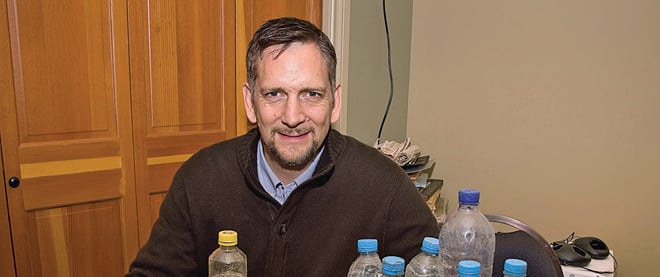Tsunami debris hits the shores of B.C.
Some scoffed when Tofino’s mayor first warned of the approaching barrage of Japanese washed-up objects. Not now.
Share

It began in December with a flotilla of bottles, cans and lumber with Japanese trade stamps washing up on the beaches of Tofino on the west coast of Vancouver Island. Mayor Perry Schmunk, among those who gathered the debris, was the first elected official to raise the alarm that wreckage from the Japanese earthquake and tsunami of March 11, 2011, was hitting the North American shore more than a year earlier than expected. While skeptics doubted Schmunk’s claims, events have proved him right.
In recent weeks an abandoned 49-m Japanese fishing vessel drifted to within 500 km of the B.C. coast before it it was sunk by the U.S. Coast Guard. A soccer ball belonging to 16-year-old Misaki Murakami, who lost his family home in the disaster, washed up on an island off Alaska. Most recently, a shipping container hit the shore of Graham Island in B.C.’s Haida Gwaii, spilling a rusting Harley-Davidson onto the beach. “I think there’s no doubt now that it’s coming ashore much quicker than everyone anticipated,” says Schmunk.
So far the largest item to hit Tofino beaches is a 45-gallon drum that once held a fish extract, but communities along North America’s West Coast expect much worse. An estimated 1.5 million tonnes of material light enough to float was swept out to sea. Much of it is expected to swirl in what is known as the North Pacific garbage patch between Hawaii and North America, but significant amounts could hit beaches from Alaska to California by October. Posters in Washington state advise beachcombers to be aware that garbage, personal belongings and hazardous material will wash ashore. “It is extremely unlikely any human remains from the tsunami will reach the U.S.,” the signs say.
In B.C., a tsunami working group has been created to help iron out the jurisdictional mess the debris represents. Wreckage offshore is a federal responsibility. Material between low- and high-tide lines is a provincial responsibility while material tossed above the high-tide mark is left for the local governments to deal with. “This potentially has significant impact for us, way more than what we could handle on a municipal level,” says Schmunk. He said he has received federal and provincial offers of help if the flotsam hits in overwhelming amounts.
Last week, the Maritime Museum of B.C. in Victoria launched a Tsunami Debris Project on Facebook. The museum is asking people to post pictures of suspected tsunami debris they find in the hope that people in Japan may recognize lost personal items.
Schmunk said none of the items found in Tofino have been traceable, but getting personal items back in owner’s hands is a priority. The rusted motorcycle, for instance, will be shipped to its owner in Yamamoto thanks to the combined efforts of the man who found it, a friend of his in Tofino and a motorcycle dealer in Langford, B.C. Harley-Davidson in Japan will restore the bike for its owner, who lost several family members in the quake.
Recently Schmunk and Bill Irving, mayor of the nearby coastal town of Ucluelet, met with Japan’s Consul-General Hideki Ito to discuss lessons learned from the disaster. Ito stressed the scars in his country cut deep, said Schmunk. “This debris has strong emotional ties to them.” The disaster has raised awareness that coastal communities like Tofino are also vulnerable to tsunamis. “We share the same ocean,” said Schmunk, “and we potentially share the same risk.”